| |
|
|
| -- May 29th to June 11th, 2024 -- |
| |
|
A little crossing of the North Sea later, and we made it to a new world: exotic landscapes, a different culture, and... wintery weather conditions!...
More picture - most of them ashore, as well as a film with nice birds in our
Photos page.
|
|

215 miles sailed
660 miles since the start
|
|
|
|
| |
|
29-30 May: Herdla – Lerwick (190M)
|
|
|
There is a small weather window to cross to the Shetland. Oh, it is not a large window, it is rather barely ajar and creating chilling drafts, but the long term forecast is way worst. So, we try and convince ourselves that it will do: force 6 is almost like force 5, the sea won’t have time to build up in 48 hours, we had stronger conditions around the Atlantic… we know that it will be sporty.
|
|
|
By contrast, we leave on flat seas under a warm sun. We are thinking to take advantage of the end of the calm to exit the last of the skjærgård islands. After one hour motoring, the northerly wind shows up and we have to tack between the rocks. Scandinavian elegance. One more lighthouse to pass, on more tack before a rock, and we will be leaving Norway…
|

A last look to our dear Norway, and we head West!
|
|

Troll, the first oil platform of the crossing.
|
Now we are on the open sea again. The northerly wind kicks in as expected, ready to increase overnight. A gannet, rather a rare bird in these regions, comes along to say hi. We welcome this good omen et set course towards the Shetland – ready to take in the sails as soon as required..
Soon we put the first reef, then a few turns on the genoa. We have the wind on the beam and are sailing fast! More than 6 knots, and we are already passing the oil platform Troll when we need to put the 2nd reef.
|
|
The sea is building up and the rain is falling – faster than the night actually! We put the 3rd reef before reading the next platform Oseberg, and furl in the genoa again. There’s a lot of activity around the platforms, working boats are crisscrossing the area, it helps to keep the one on watch awake!
At dawn, 3am, we take the main sail down. The wind headed a little and the boat is not well balanced with the furled genoa only, but we don’t feel like going in front of the mast to rig the jib, now that there is a short and steep swell. It’s cold, it’s raining, waves are regularly washing over the deck and enters in the mess as soon as the hatch is not pulled enough. Everything is soaked and sticky with salt, this is not a comfortable passage. It’s only the dozens of birds flying around so close they nearly touch the shrouds, who seem to be having fun. These are mostly fulmars, and a few gannets too.
|

Dusk is setting, the light towards the North will stay for the whole "night".
|
|
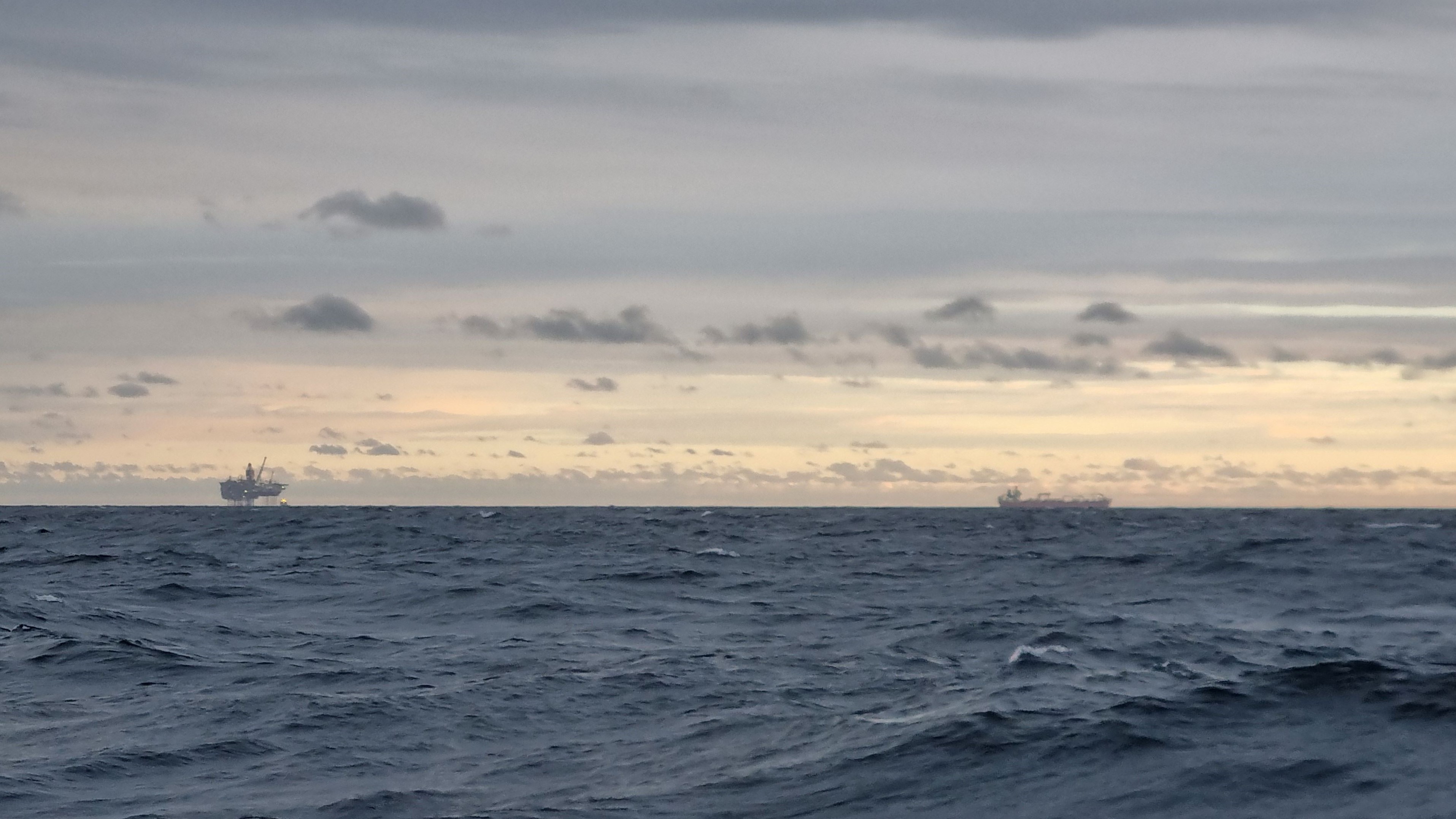
Martin Linge, the last norwegian platform before British waters.
|
In the conditions we do 2 hours watches, this is long enough for the one who is on watch. We spend most of the time inside, where it’s warm and where we are not so impressed by the weather, since we cannot see the waves or feel the wind! After passing the last platform, shortly after the border, we won’t be seeing any other boat actually. The wind is still strong but stable, there’s only about hundred of miles to go, we just need to hold tight and hope nothing breaks.
|
|
We struggle to find our flow on this passage. The conditions are uncomfortable and we keep up the watches during the day too. It’s almost impossible to sleep in the front cabin shaking in all directions, but at least we are warm under the two blankets. We are progressing fast and cannot but start thinking about possible arrival time – which is the best way not to enjoy the trip itself.
Yet, the situation is improving. For one, it stopped raining! The barometer is up. The skies clear enough for the solar panel to charge our batteries. Shortly before lunch, the wind is down a few knots and we hoist the sail again with three reefs. The boat is grateful, riding much smoother on the swell, which actually doesn’t break so much even…
|
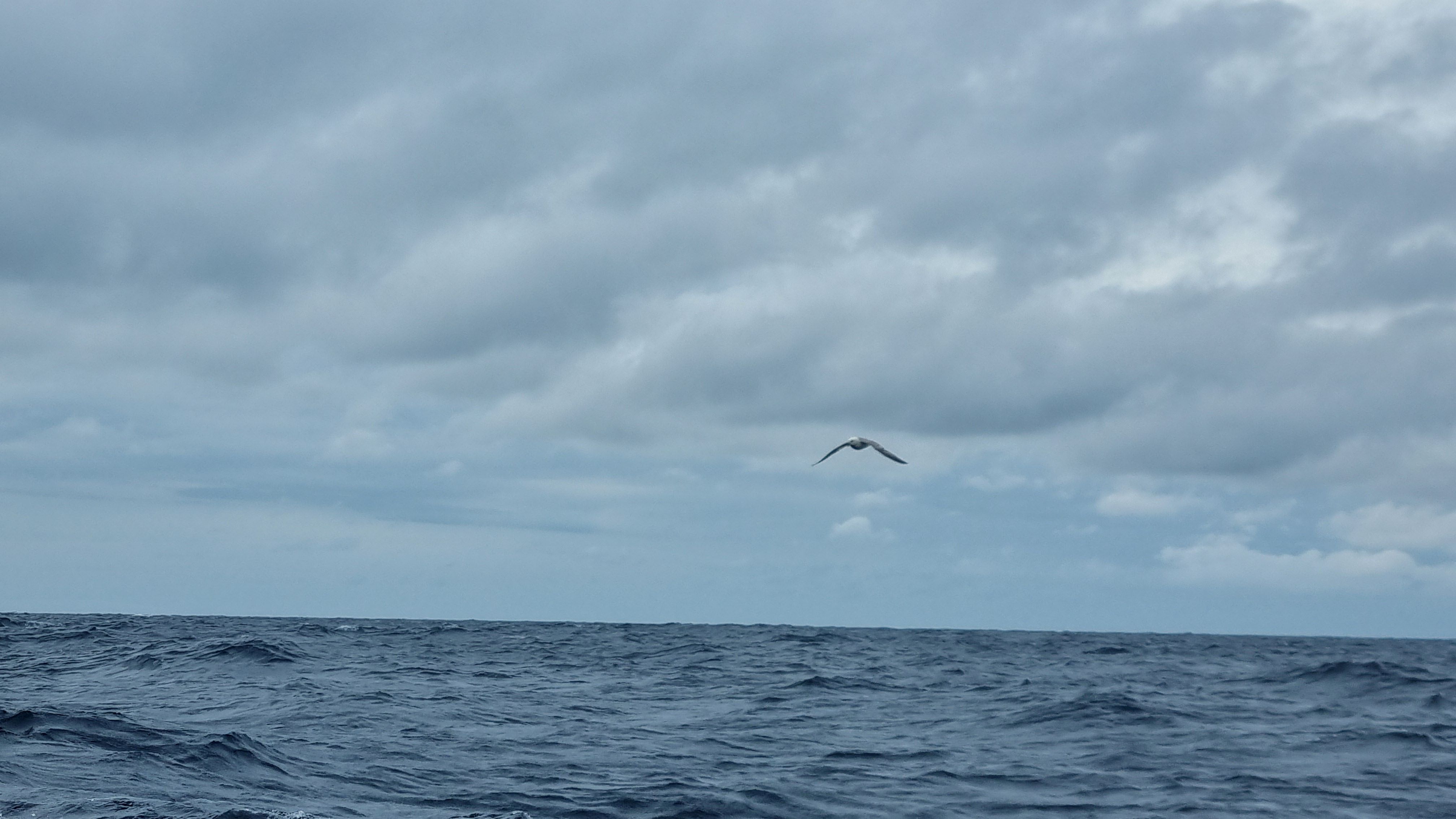
Fulmars, our sailing companions for this crossing
|
|
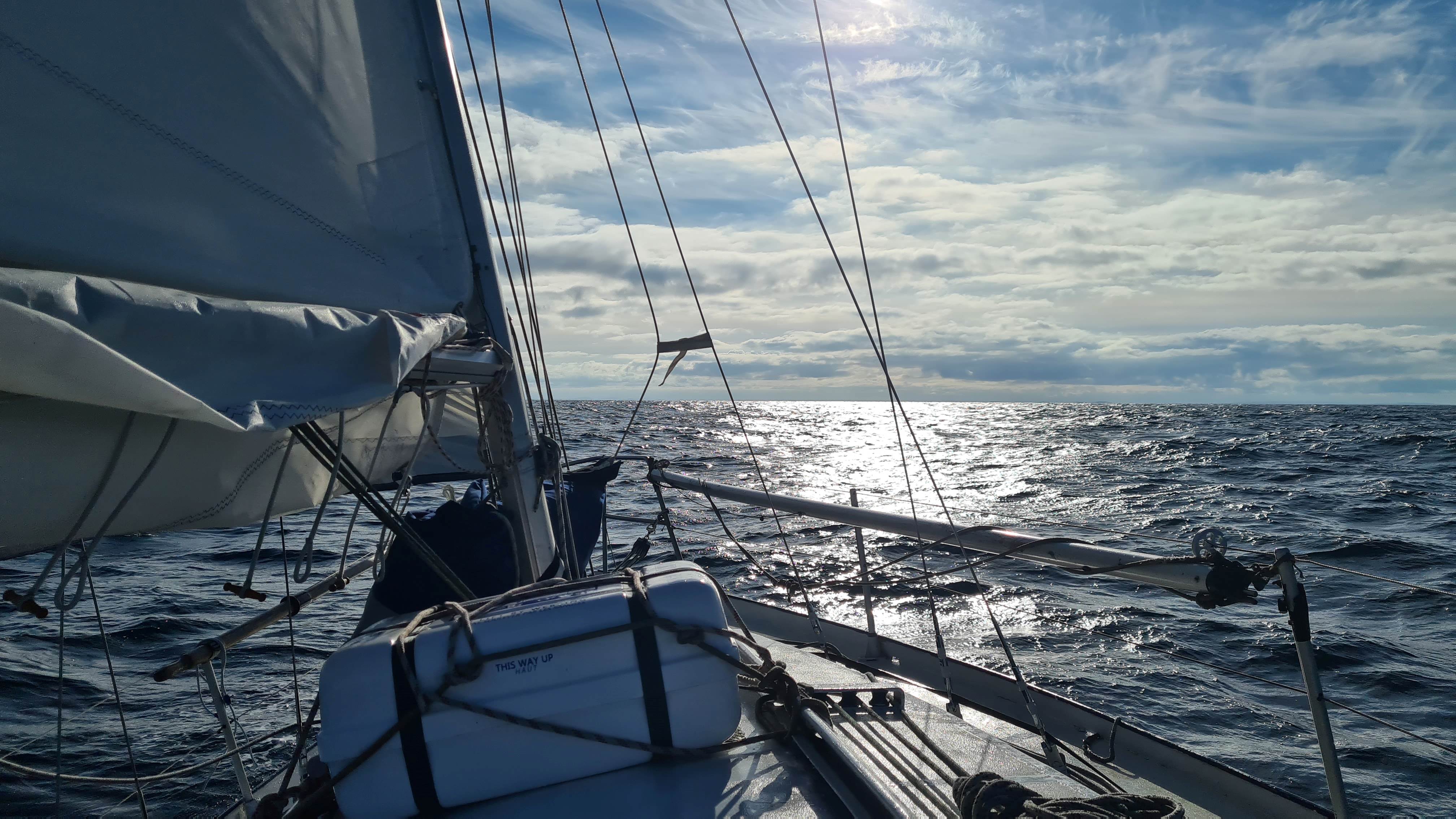
After a rather uncomfortable crossing, the arrival is actually nice enough!
|
In the afternoon we venture outside, as the sun is shining and the waves less frequent over the deck. Birds are still flying around the boat. We could almost start to enjoy and find it beautiful here…
The mainsail comes back to 2 reefs as we start seeing the Shetland islands over the horizon. They are still 40 miles away, but the conditions are much nicer now! The wind is decreasing steadily, contrary to the last weather forecast we got before leaving. A little surprised, we find ourselves all sails up under the rising sun, approaching the Shetland surrounded by fulmars! The gift of a splendid landfall.
|
|
Still a little way to go until the harbour, the wind is stable at 10 knots and we cover the ground quietly and with a favourable tidal stream. Lerwick Harbour is a busy place, it is necessary to call the “harbour control” on VHF (ch.12) before entering the channel, even at 1am.
We are cleared to enter and berth at the visitors’ quay. We crossed the North Sea – and in record time of 37 hours including manoeuvres, for a distance of 190 miles! Without counting the harbour manoeuvres, we sailed at an average of 5.5 knots during 36 hours – like a rocket, little Saltimbanque! The crew is satisfied and goes to bed.
|

A first glimpse of the islands, we will investigate more after a good night of sleep!
|
|
|
31 May : Lerwick – Noss – Lerwick (25 M)
|
|
|
We are still surprised to be already in the harbour and not still at sea, as we wake up in the morning. First things first: harbour office (to do the clearance), dry up the boat and shower at the boating club!
|
|
|
Once clean and more awake, we can have a better look at the weather: a deep low is forecasted for the rest of the week, but today and tomorrow morning the conditions are still manageable. If we want to go and anchor somewhere, now’s the time!
|

But before we may consider leaving, we need to get the boat a bit dryer!
|
|

The old-gaffer "Swan of Shetland" sails in front of a new landscape
|
We leave again with the intention to anchor by Noss island, the bird reserve located 8 miles from here. The sea is calm and we take in all these wonderful new landscapes. We are in the Shetland, for real! The islands are lower than in Norway, more like rolling hills and steep cliffs, without a single tree to disturb the perspectives. No tree at all!
|
|
We expect little wind and we are happy with sailing slowly by the cliffs and watching the birds: gannets, fulmars, guillemots, even puffins!
As we approach the anchorage at Noss however, the wind has picked up and veered South-West rather than North-West, we don’t feel like dropping the anchor there any more. There’s another possible place we identified 12 miles North, so we decide to try our luck there.
|

The cliffs of Bressay, and the island of Noss in the background.
|
|
|
On the way, we just have to sail around Noss, which is a nice island surrounded by tall cliffs. We are rounding the southern tip as the island’s treasure is revealed: vertical cliffs like ready-made buildings housing thousands of birds. Hundreds of thousands of gannets, actually. Every 30 cm there’s a gannet. Over 200 m height there are gannets. The sea is covered with gannets. We are surrounded by gannets, flying around in all directions. Incredible moment…
|
|
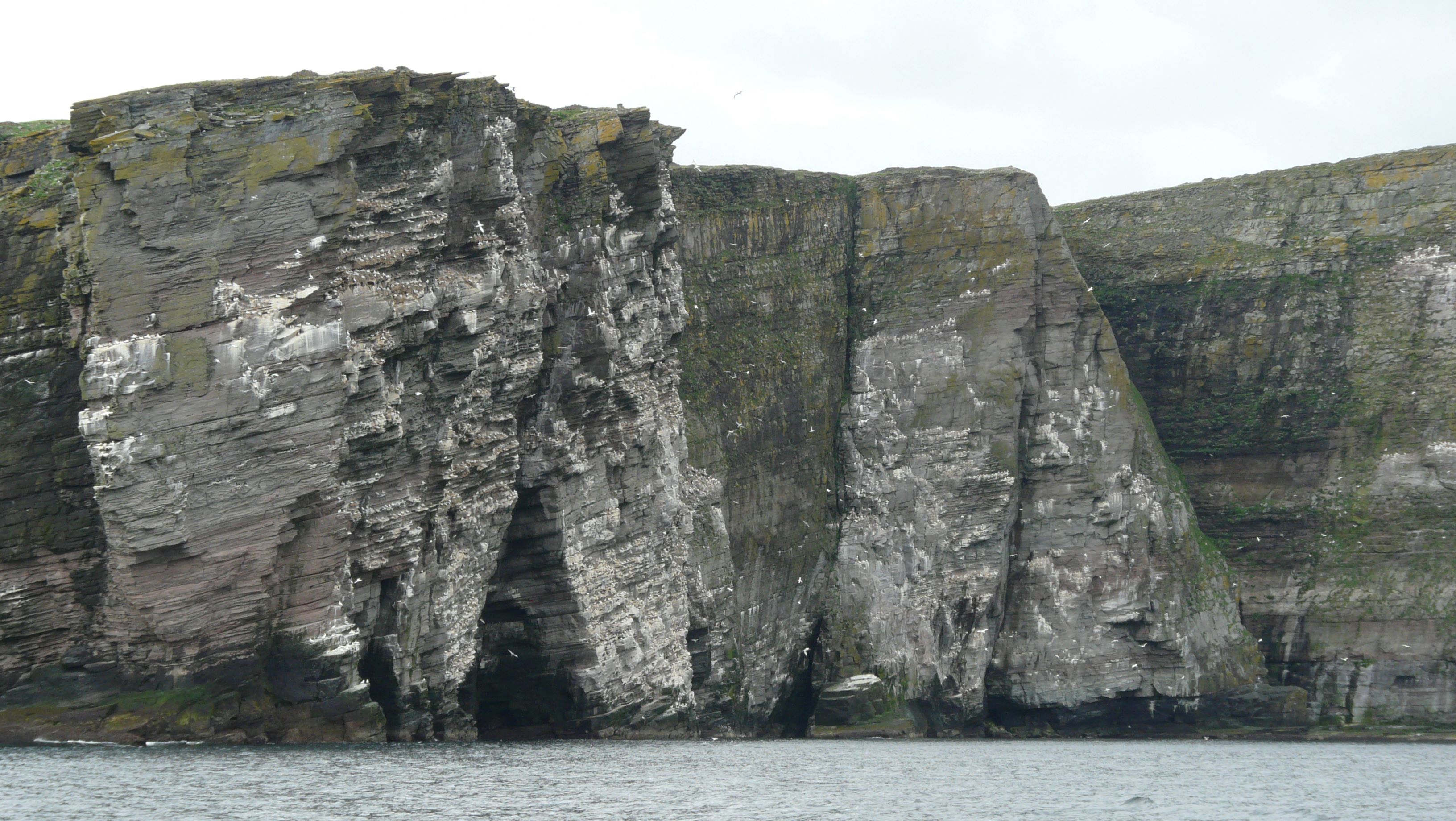
The cliff of the island os Noss...
|
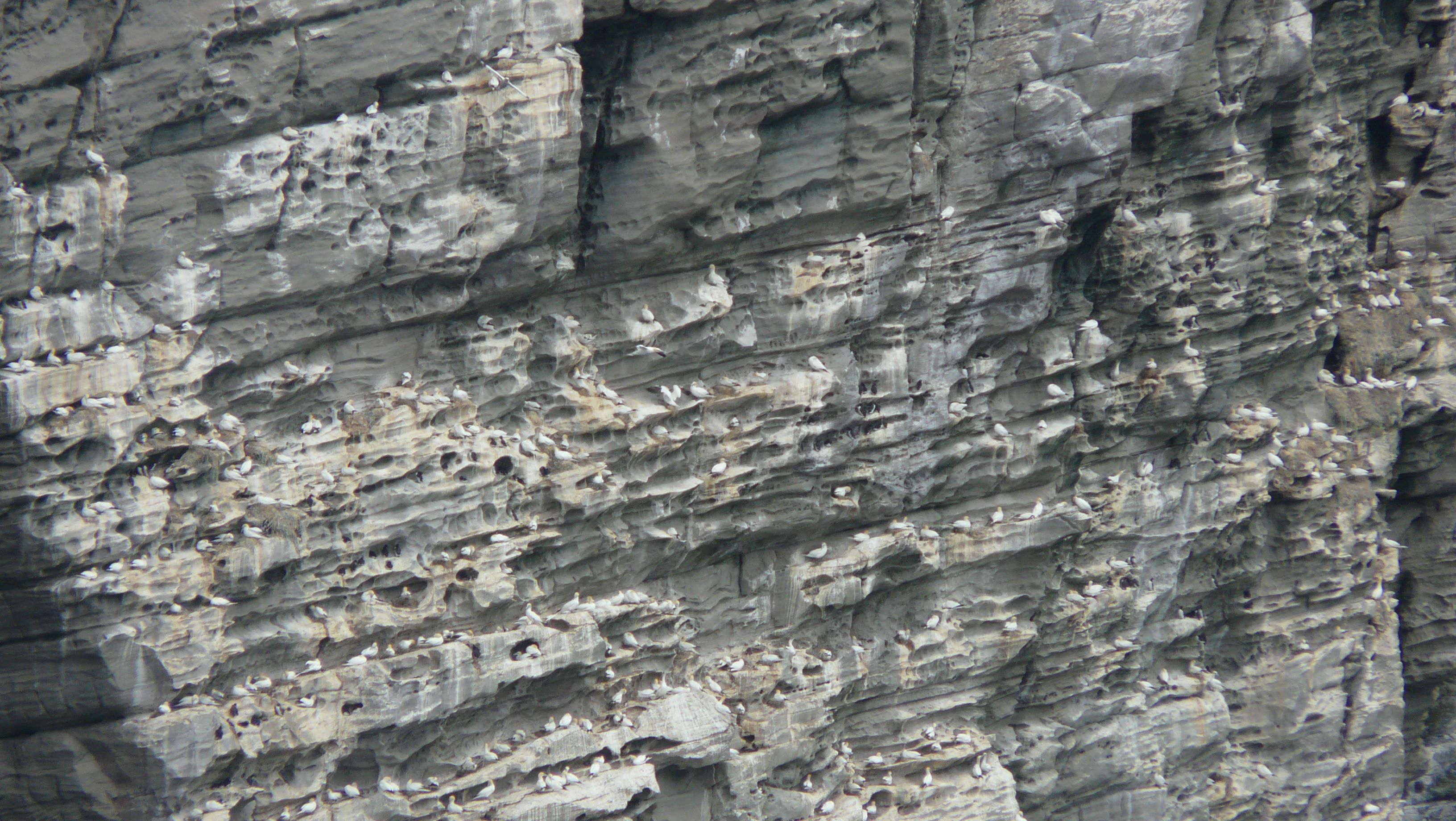
... happens to be packed with gannets
|
|
We stay there for a while, admiring the birds before starting on our way again, still under the charm of this unexpected encounter. Time is flying, and we start to feel a little tired and eager to find that anchorage. The wind picks up, then heads, then picks up again. Once we get there, we find strong gusts.
It’s raining, it’s cold and windy, we decide to throw in the towel and come back to Lerwick to get a good night sleep. In the end, we have had a nice day of sailing around the islands and it’s time to settle in at quay, for a long spell of bad weather…
|

And this night we will dream about gannets!
|
|
| TOP
|
| |
| |
|
1 to 11 June : Lerwick (ashore))
|
|
|
The low pressure we are seeing coming since Bergen is here, and decided to stay a little longer in the North Sea with the gannets and the fulmars. No weather window as far as the forecast can see, we are stuck in Lerwick until the end of times.
|
|
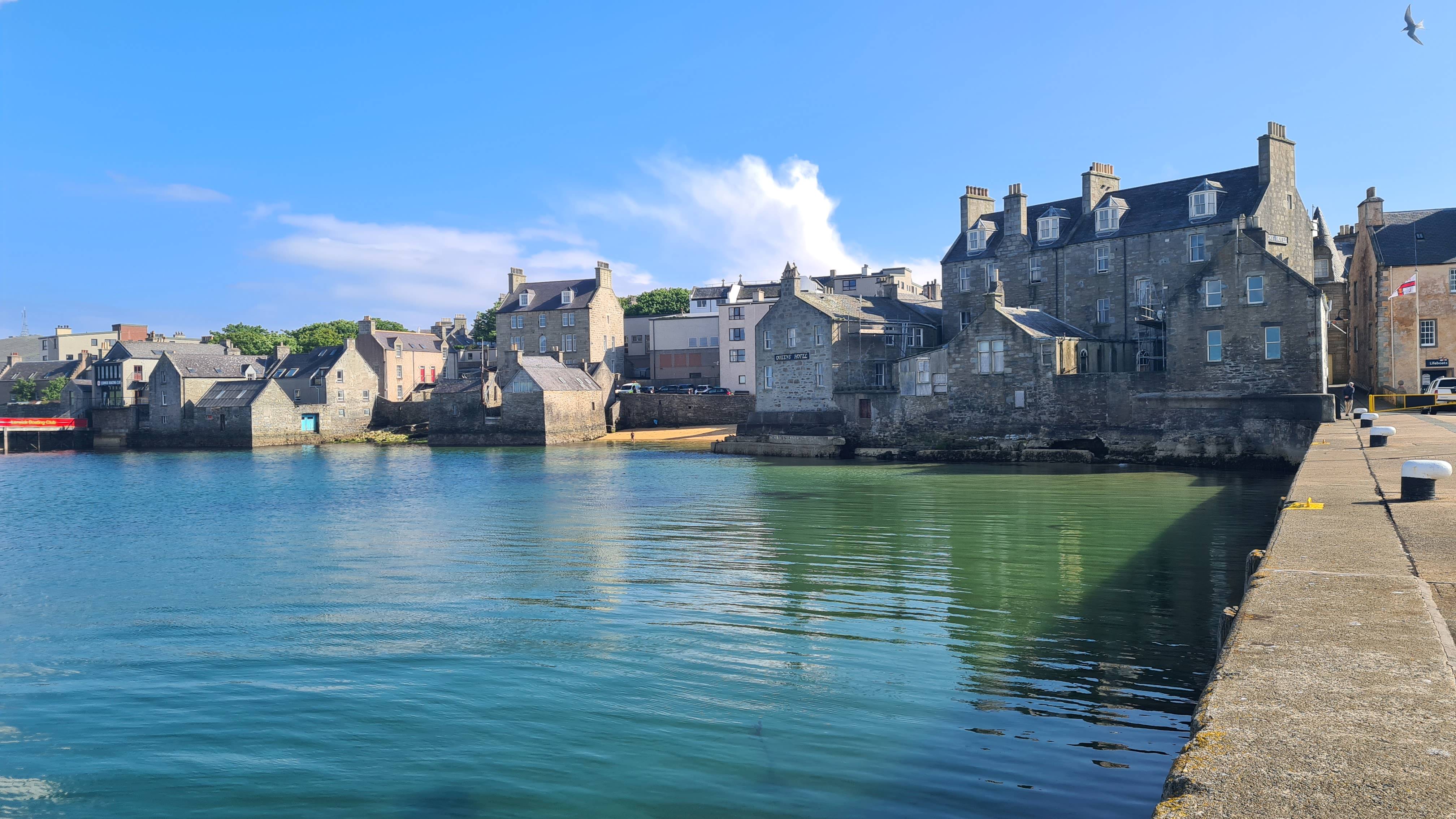
The harbour surroundings are very picturesque
|
We are not alone! A dozen of more or less long distance sailing yachts are here too, and contrary to Norway, people talk here. We meet other sailors with whom to chat, have a beer, exchange information etc. There is the Danish boat Lucca, on which we rafted: he is sailing alone and enjoys having someone to compare weather analysis with. There are the French from Nantes, onboard Dibona, with whom we spend a few nice evenings: they know Scotland, we know Norway, conversation topics are obvious! There are also the Americans on Wayfarer, a beautiful 45ft in aluminum, all wooden equipment inside, built in Holland. They have been living onboard for 40 years and we listen avidly to the stories of their adventures in Patagonia.
|
|
|
As a backdrop to this busy social calendar, the wind is blowing, the rain is wet and the temperature is dropping … 6 degrees in the morning, 9 at the warmest of the day, the sea is at 9 too, our “fridge” never worked so well! Laure manages a first swim of the trip, attracted for the beautiful clear water shining in the rare sunshine… but there are definitely more seals – and even an otter – than swimmers around.
|
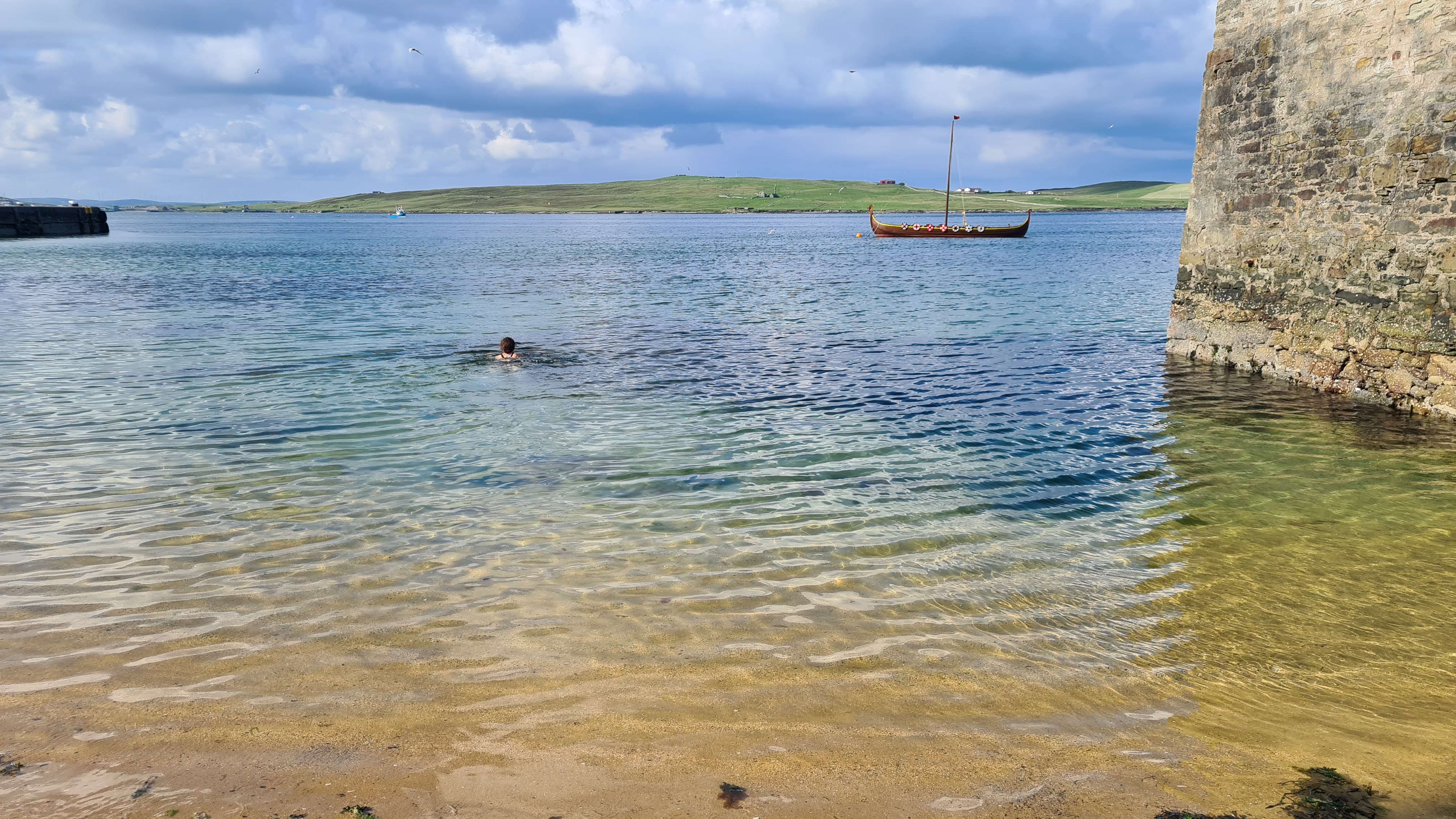
First swimm of the trip for Laure, hats off !!
|
|

We are now doing "menage a 3" with our dear heater
|
We have seldom been stuck at the same place for that long, the routine sets in. Wake up in the chilly front cabin (9 to 11 degrees), dripping wet with condensation, quick look at the maritime weather forecast and disappointment at the realization that the possible window, suspected the previous day, closed during the night – then another look at the land weather forecast to choose, according to the amount of rain, between chores indoors, or hikes exploring the islands. In the evening, we head to the boating club for a shower and access to the wifi. Then we chat with the neighbors until dinner, in a closed boat huddled by the small electric heather, before snuggling under two duvets with a water bottle. After all, we are dreaming about Patagonia: this is a good training period, both of resistance to the cold and of patience (which is famously not our strong suit).
|
|
Lerwick, for all of its 7000 inhabitants, is a “large city” and all services are available to sailors: laundry, supermarkets, mechanics, shipshandlers, electricians etc. All delivered by the kindest people we met, who are trying their best to help. Do we need £1 coins? No problem, the young sales assistant at the bank gives us all the stock he has (and changes our old paper notes to new plastic notes in the process). Do we have a question on the engine? Off course, the mechanic drops what he's doing and answers our worried questions about a new noise in the silent-block. Are we looking for campingaz bottles? The cannisters have just arrived after 10 months out of stock, and the dealer tried to call us the whole afternoon to let us know, before finally driving us back to the harbor to save us a couple of kms with a heavy backpack. On the streets, manicured gardens (often populated by sea-themes garden gnomes) surround neat houses in stone, everything is nice and clean… what a welcoming place!
As we quickly discover, the Nordic links run deep here. Shetland and Orkney remained under control of the Norwegians / Danish from the 800s until 1472, when they were mortgaged as dowry for the wedding of the princess of Denmark to the prince of Scotland. Place names are oddly familiar (lots of -vik and -veien and -ness), the local dialect “Norn” spoken until mid/end 1800s here was directly descendant of Old Norse. Even now, random conversations here and there with locals make it clear that they feel closer to their neighbor across the water to the east, rather than their distant ruler in the South… All in all, as far as weather-prisons go, this one is not the worst…
Another advantage about Lerwick is the well-organized tourist office: the hostesses greet foreigners (also the hordes from occasional cruise ships, higher that the city itself) with a smile and very detailed brochures. They even have worked out the bus and ferry timetables and printed sheets with the combinations useful to explore further islands!
Our first excursion leads us to Scalloway, which used to be the capital of the archipelago until 1700. Now a village of 900 inhabitants, it contains the ruins of a tall castle from the early 1600s, a few colourful old houses, the traces of the heroical deeds of the Norwegian resistance movement who sought refuge here during the nazi occupation, a museum (inaugurated by the Norwegian Prime Minister himself), and a quay just long enough to harbour a few support vessels to the oil industry. We quickly find ourselves on the coastal path, progressing in the middle of a Shetland postcard: furious sea breaking on the rocks, fish farms, sheep and Shetland ponies, dilapidated houses and seabirds – more or less friendly. The principal occupants of this domain are terns and oystercatchers. The latter are clearly in charge of security, watching over the nests probably: they stand like sentinels, each posted on the top of a wall or a chimney, and start crying as we approach, in a way strongly reminiscent of a car alarm. The terns squadrons then rush in, shouting menacing clicking sounds closer and closer to our ears. We accept defeat and retreat…
|
|

Are we in Scotland maybe?...
|

... sure, but clearly in Shetland!
|
|
|
A few days later, another bus takes us to the South of the Mainland: Sumburgh. First we walk up to the lighthouse. Here again birds are everywhere. This time colonies of guillemots mainly are building their homes on the cliffs painted rose by sea pinks – as well as a few puffins!
|

The fulmars are ensuring the show in between the flowers on the cliff of Sumburgh
|
|
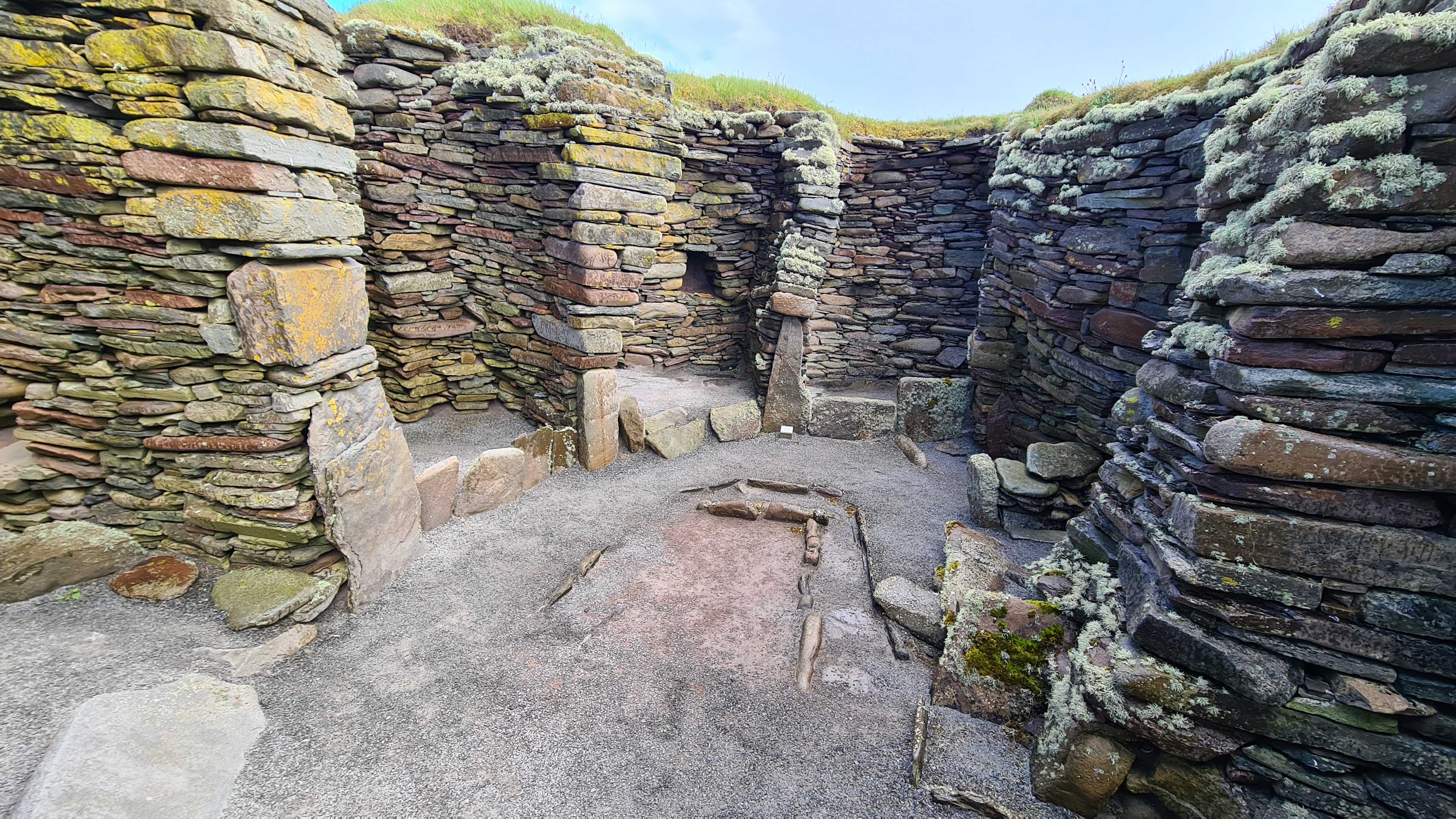
A typical "wheel house" (~200 BC)
|
Then we visit the prehistoric site of Jarlshof: round houses up to 4000 years old, complemented over time by a “Broch” (a round tower typical of the Scottish Iron Age) then by viking houses and even a castle from the 1600s. Very impressive, and an amazing run-through across the Shetland history, all in one site!
|
|
|
And to end the day on a good note, some fast walk on the coastal path to keep warm…
|

Sight towards Sumburgh head, the southern end of Shetland.
|
|

The local supermarket, where we buy our dessert!
|
Finally, the most ambitious of our excursions: the island of Unst, northernmost of the archipelago. To go there, one has to take a bus (easy), a ferry (very Norwegian, it even smells like grilled pølse!), another bus (or rather a large van), another ferry (smaller, which smells like old working boats), finally a last bus as small as the previous one. The driver who drops us at the end of the road leaves us with very clear instructions: meet at the tea-house at 16.15. We ask where bus stops down the line are, in order to be more flexible, but the answer is always the same …
Oh well, we’ll understand later probably. For now, we are heading to the Hermaness reserve at the North of the island (as the Lonely Planet there: “you are fast running out of Scotland when you reach here”!). Along the road a wooden box closed with a piece of string and a nail claims “eggs and cakes”. The system is simple: help yourself, put the coins in the box. Perfect for dessert!
|
|
|
The walking path leads to a viewpoint opening on the Muckle Flugga, the last rocks before the open sea, direction the North Pole … hey, there’s a ferry passing by actually, it must be coming from Island or the Faeroes…
|
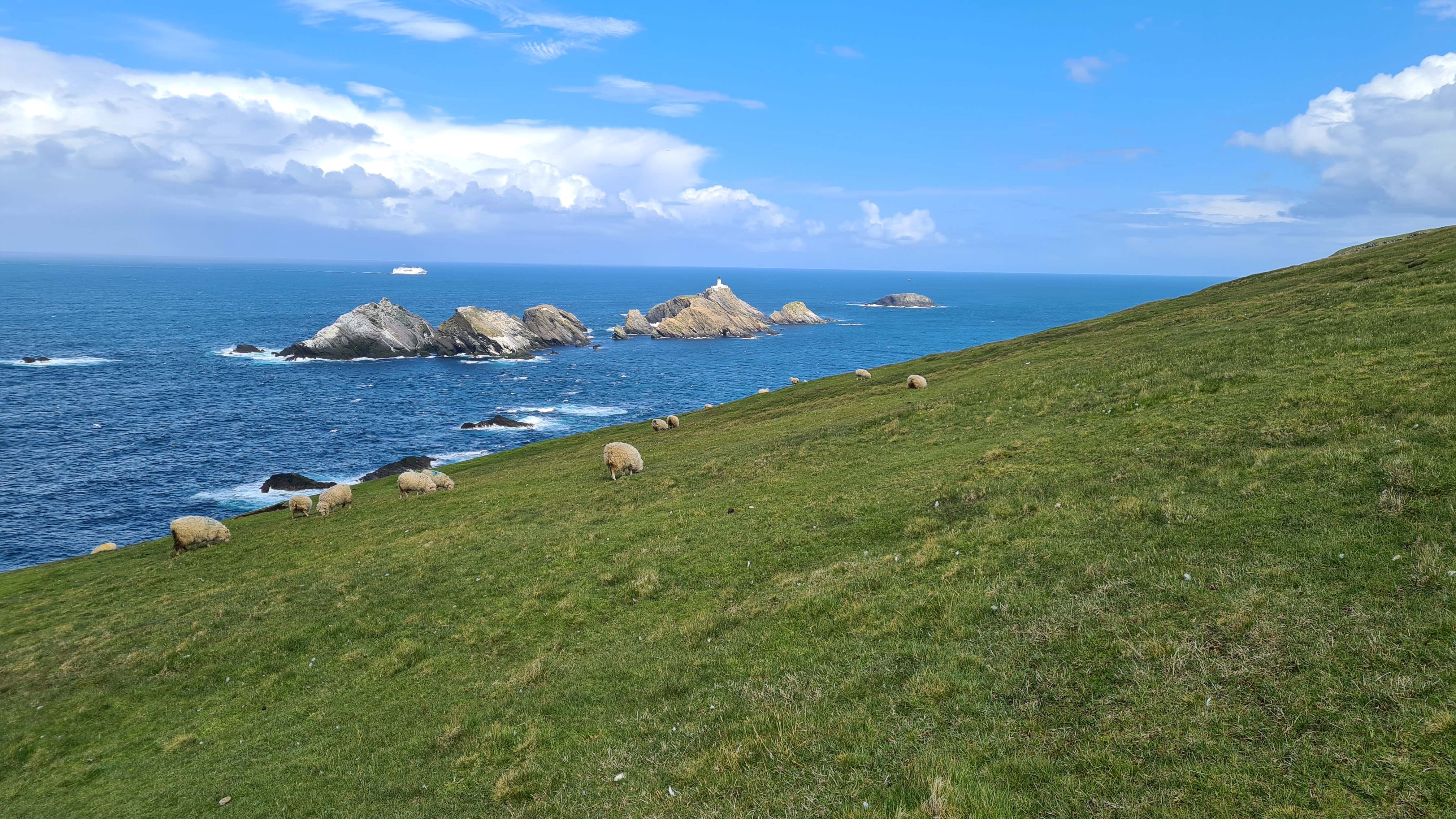
Muckle Flugga, the northern end of United Kingdom
|
|

Amazing wild landscape on the west coast of Unst
|
The landscape alone is magnificent, so when you add to it hundreds of gannets, skuas and puffins (5% of Europe’s population lives here), it is borderline immodest… We have seen birds over the last 10 days, but we are struck by the beauty of nature’s spectacle here… worth the hours of transport and the 18km walking under the rain! (Luckily they are fewer today, and we never go out without our “Shetland gears” now: raincoat, waterproof trousers and backpack)..
|
|
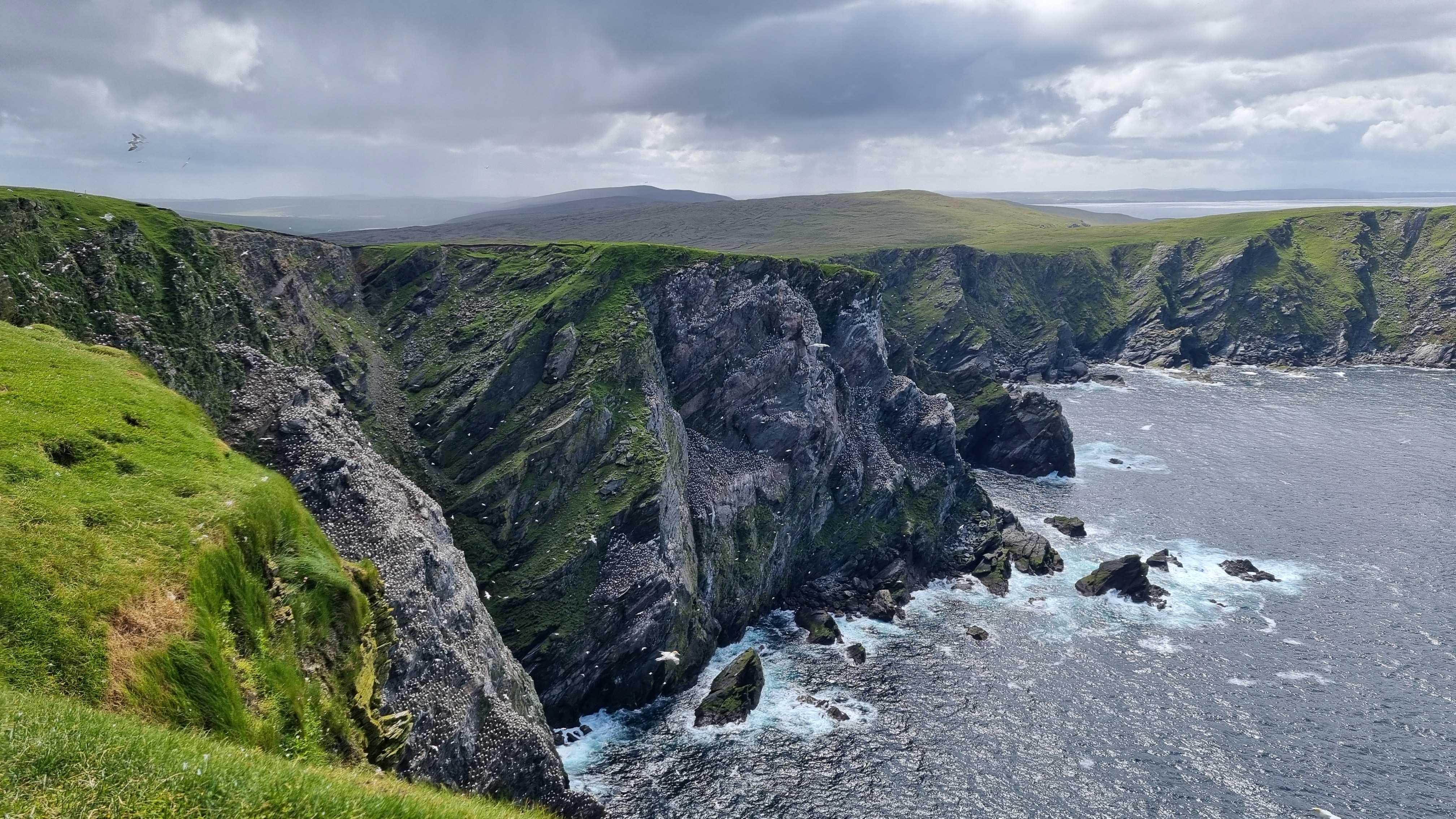
Thousands of gannets by the cliffs...
|
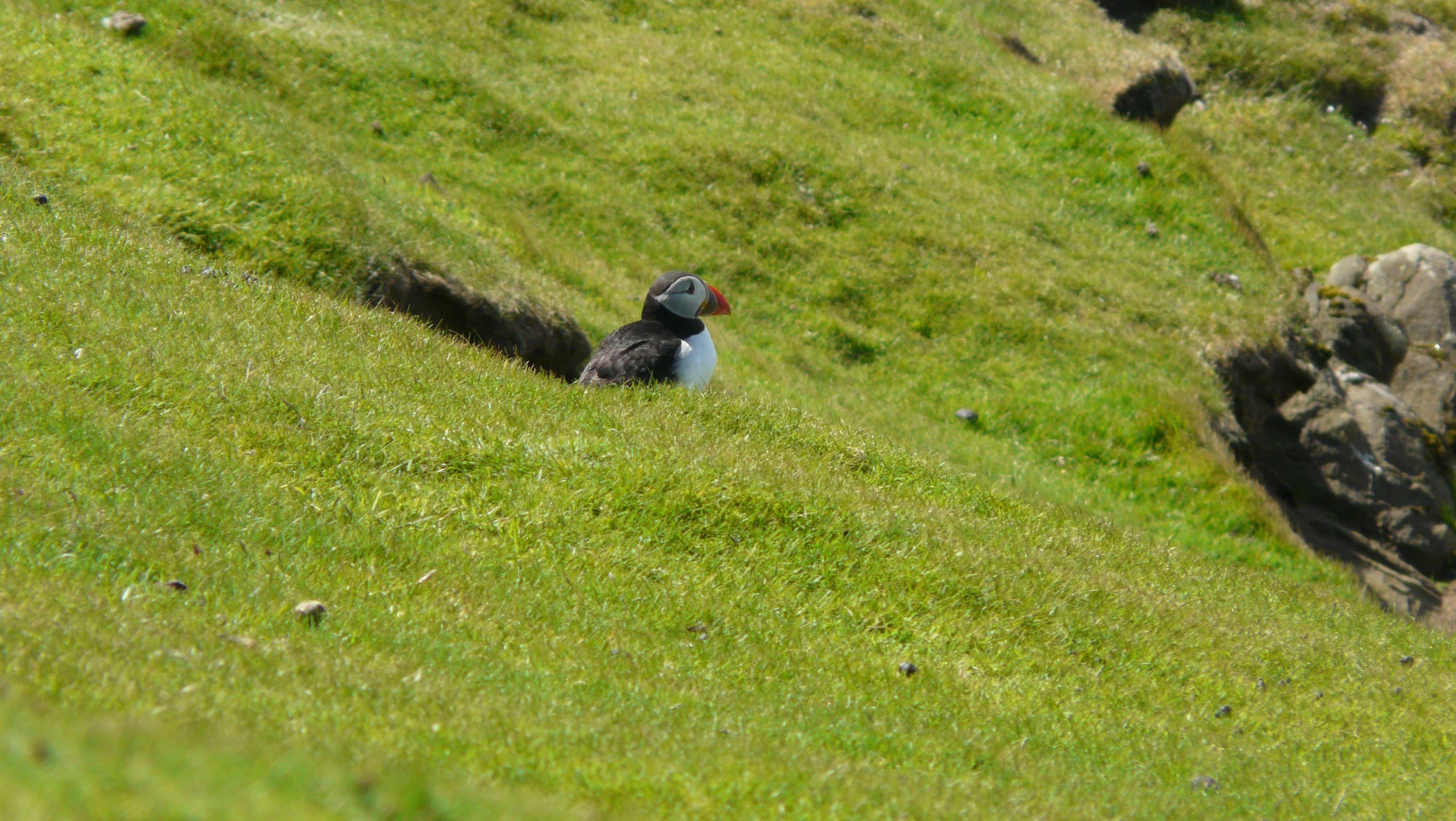
... not forgetting the local star, the cute little puffin !
|
|
The afternoon finds us back to Haroldswick “center” with a few moments to spare before our appointment, which we employ in the interesting (and warm!) Cultural Heritage Center learning about the island’s geology and development. The place is a typical example of “crofting” lifestyle common all over Northern Scotland: most people were tenants, living on land owned by richer landowners, and surviving on a mix of farming (sheep, geese, pigs and one cow for the milk and butter – currency in which taxes were paid), coastal fishing (with small open boats and traps), and agriculture limited to what would grow here (barley, oat, some potatoes and cabbage / kale). Ponies were used to carry the all-important peat for fires and ovens.
16.15, we stand at the meeting point outside the tea-house. No bus… But a simple car, no bigger than a Twingo, stops there: “Hi, I am the bus! Are you coming?” This trip is becoming more and more folkloric! We understand from the driver that this “bus” trip has to be booked, otherwise it doesn’t run, despite being list on the official timetable. Good that the drivers talked to each other and picked up the two weird Frenchies roaming around!
During the trip back across two thirds of the islands, we have a good view of the main activities: sheep and ponies grazing, grass or moorland as far as the eye can see, peatlands – vital on this treeless land, the large oil terminal collecting crude from the British offshore platforms, wind turbines of different ages and degree of sophistication, and fish farming multiplying in every sound (round for salmon, in lines for mussels).
|
|
|
As we are writing these lines, the wind seems to be easing soon for a few days and may even let us continue our voyage towards the Orkney islands…
|
|
| TOP
|
| |
| |
|
|
|
|
|
|
| |
| |
| TOP
|
| |
| |
| |
| |
|





































